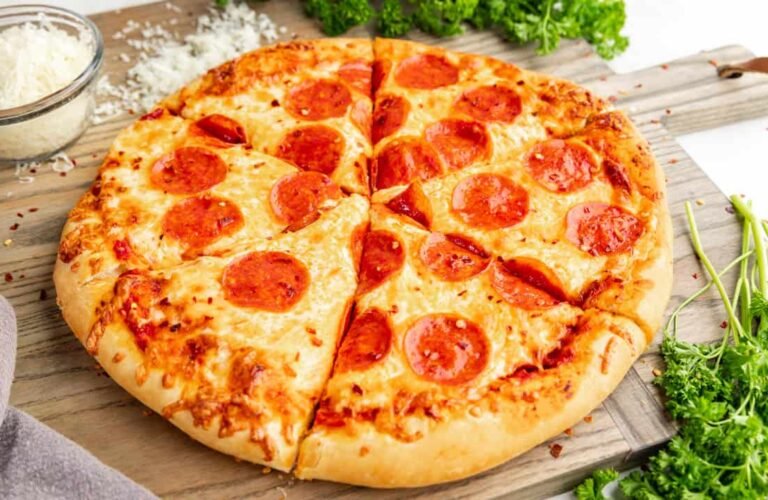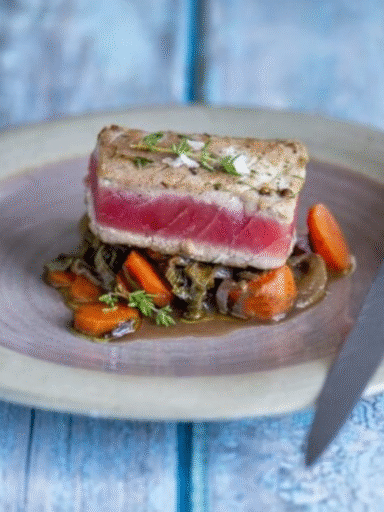Sheet Pan Pizza is the ultimate solution for a delicious, homemade meal that’s easy to prepare, endlessly customizable, and perfect for feeding a crowd. Baked on a single sheet pan, this pizza delivers a crispy, golden crust with a fluffy interior, topped with your favorite ingredients, from classic pepperoni to vibrant veggies. Its rectangular shape makes it ideal for slicing into shareable squares, perfect for family dinners, game nights, or casual gatherings. Requiring minimal equipment and basic pantry staples, Sheet Pan Pizza is accessible to novice cooks yet versatile enough to impress seasoned chefs. In this professional guide, we explore the art of crafting the perfect Sheet Pan Pizza, complete with a detailed recipe, ingredient insights, variations, serving suggestions, and expert tips. With a preparation time of about 1 hour (including dough rising), this 2,000-word article equips you to create a restaurant-quality pizza at home, tailored to your tastes and dietary needs.
Why Sheet Pan Pizza?
Sheet Pan Pizza, sometimes called Sicilian or grandma-style pizza, combines the best of thick-crust and thin-crust worlds, offering a chewy, crispy base that holds up to generous toppings. Unlike traditional round pizzas, its rectangular shape maximizes surface area, making it ideal for feeding 6–8 people with one pan. The method is forgiving—using a standard half-sheet pan (18×13 inches), it doesn’t require a pizza stone or specialized oven, and the dough is simple to stretch. Costing roughly $10–$15 to make, it’s budget-friendly compared to takeout ($20–$30 for a large pizza). Its versatility allows for endless flavor combinations, from meat-lover’s to vegan, and it’s easily adapted for gluten-free or whole-grain diets. Whether you’re hosting a party or craving a cozy night in, Sheet Pan Pizza delivers comfort, flavor, and fun in every slice.
The Recipe: Sheet Pan Pizza
This recipe serves 6–8 and takes about 1 hour total (15 minutes prep, 30–45 minutes rising, 15–20 minutes baking). It yields a crispy, golden pizza with a classic marinara and mozzarella topping, customizable to your preferences. Below, we outline the ingredients, step-by-step instructions, and tips for success.
Ingredients
For the Dough:
- All-Purpose Flour: 4 cups (480g), or bread flour for extra chewiness
- Warm Water: 1 ½ cups (360ml), 100–110°F (38–43°C)
- Active Dry Yeast: 2 ¼ tsp (1 packet)
- Sugar: 1 tsp, to activate yeast
- Olive Oil: 3 tbsp, plus 2 tbsp for the pan
- Salt: 2 tsp
For the Topping:
- Marinara Sauce: 1 ½ cups (360ml), store-bought or homemade (see below)
- Mozzarella Cheese: 3 cups (340g), shredded, low-moisture preferred
- Toppings: 1–2 cups, e.g., pepperoni (100g), bell peppers (1 cup diced), mushrooms (1 cup sliced), or olives (½ cup)
- Dried Oregano: 1 tsp, for flavor
- Parmesan Cheese: ¼ cup (25g), grated, optional
- Red Pepper Flakes: Optional, for heat
Quick Marinara (Optional):
- Canned Crushed Tomatoes: 1 cup (240ml)
- Garlic: 1 clove, minced
- Olive Oil: 1 tbsp
- Salt: ½ tsp
- Dried Basil: ½ tsp
Equipment
- Half-sheet pan (18×13 inches)
- Mixing bowl
- Measuring cups and spoons
- Kitchen towel
- Oven
- Small saucepan (for marinara, if making)
Instructions
- Activate the Yeast: In a small bowl, combine warm water, sugar, and yeast. Stir gently and let sit for 5–10 minutes until foamy, indicating the yeast is active.
- Make the Dough: In a large mixing bowl, combine flour and salt. Pour in the yeast mixture and 3 tbsp olive oil. Stir with a wooden spoon or your hands until a shaggy dough forms. Knead on a lightly floured surface for 5–7 minutes until smooth and elastic. If sticky, add 1 tbsp flour at a time.
- Let the Dough Rise: Place the dough in a lightly oiled bowl, cover with a damp kitchen towel, and let rise in a warm place for 30–45 minutes until doubled in size. (Tip: Preheat your oven to 200°F, turn it off, and place the bowl inside for a cozy rising spot.)
- Prepare the Marinara (Optional): In a small saucepan, heat 1 tbsp olive oil over medium heat. Add minced garlic and cook for 30 seconds until fragrant. Stir in crushed tomatoes, salt, and dried basil. Simmer for 10 minutes, stirring occasionally. Set aside to cool.
- Preheat the Oven: Set to 450°F (230°C). Place a rack in the lower third of the oven for a crispier crust.
- Shape the Dough: Grease the sheet pan with 2 tbsp olive oil, ensuring the sides are coated. Place the risen dough in the center and gently stretch it to fill the pan, pressing with oiled fingers. If it resists, let it rest for 5 minutes and try again. Cover and rest for 10 minutes.
- Add Toppings: Spread the marinara sauce evenly over the dough, leaving a ½-inch border. Sprinkle with mozzarella, followed by your chosen toppings. Finish with oregano and parmesan, if using.
- Bake: Bake for 15–20 minutes, rotating the pan halfway, until the crust is golden and the cheese is bubbly and slightly browned. Check the bottom for crispiness by lifting with a spatula.
- Serve: Let the pizza cool for 5 minutes, then slice into squares or rectangles using a pizza cutter or sharp knife. Sprinkle with red pepper flakes if desired. Serve hot with a side salad or dipping sauces like ranch or garlic butter.
Nutritional Information (per slice, based on 12 slices)
- Calories: ~250 kcal
- Protein: 10g
- Fat: 12g
- Carbohydrates: 28g
- Fiber: 2g
- Sodium: ~600mg (varies by toppings)
Tips for Perfect Sheet Pan Pizza
Achieving a crispy, flavorful pizza requires attention to technique. Here are expert tips to elevate your results:
- Use Bread Flour for Chewiness: Bread flour’s higher protein content (12–14%) creates a sturdier, chewier crust compared to all-purpose flour (10–11%). If using all-purpose, knead longer to develop gluten.
- Oil the Pan Generously: A well-oiled pan ensures a crispy, golden crust that releases easily. Don’t skimp on the 2 tbsp olive oil, and spread it up the sides to prevent sticking.
- Don’t Overload Toppings: Too many toppings can make the pizza soggy. Use 1–2 cups total, and pre-cook watery vegetables like mushrooms or zucchini to release moisture.
- Check Yeast Freshness: If the yeast doesn’t foam, it may be expired. Test with a pinch of sugar in warm water before mixing the dough to avoid a flat crust.
- Store Leftovers Properly: Refrigerate leftovers in an airtight container for up to 3 days. Reheat in a 350°F oven for 8–10 minutes to restore crispiness. Freeze baked slices for up to 2 months, reheating without thawing.
Variations and Customizations
Sheet Pan Pizza is a canvas for creativity, accommodating diverse tastes and dietary needs. Here are popular variations:
- Vegan Pizza: Use plant-based cheese (e.g., Daiya or Violife) and skip meat toppings. Add roasted veggies like eggplant or artichokes for heartiness. Ensure marinara is vegan (no parmesan).
- Gluten-Free Pizza: Substitute gluten-free flour blend (e.g., Bob’s Red Mill 1:1) for the dough. Add 1 tsp xanthan gum if not included in the blend, and reduce water slightly to avoid stickiness.
- White Pizza: Skip marinara and brush the dough with olive oil, garlic, and rosemary. Top with ricotta, mozzarella, and spinach for a creamy, herbaceous twist.
- Meat Lover’s Pizza: Add pepperoni, sausage, bacon, and ham (1 cup total). Pre-cook sausage to avoid excess grease. Pair with a spicy marinara for kick.
- Mediterranean Pizza: Use pesto or hummus as the base, topped with feta, cherry tomatoes, olives, and red onions. Finish with arugula after baking for freshness.
- Breakfast Pizza: Spread a base of scrambled eggs or white sauce, then top with cheddar, bacon, and diced potatoes. Bake until bubbly, and garnish with chives.
These variations make the pizza adaptable for kids, adults, or special diets, ensuring everyone enjoys a slice.
Serving Suggestions
Sheet Pan Pizza is a complete meal but shines with thoughtful sides and presentation. Here are ideas to enhance your dining experience:
- Sides: Pair with a Caesar salad, roasted vegetables, or garlic knots for a balanced meal. For dipping, offer marinara, ranch, or garlic butter ($1–$2 to make).
- Beverages: A cold beer (e.g., IPA or lager) complements the pizza’s savory flavors. For non-alcoholic options, try sparkling water with lemon or a fruity iced tea. Red wine like Chianti pairs well with marinara-based pizzas.
- Presentation: Slice into uniform squares for easy sharing. Serve on a wooden board for a rustic vibe, and sprinkle with fresh basil or parsley for color. Use pizza stands or tiered trays for parties.
- Occasions: Perfect for game nights, birthday parties, or casual dinners. Cut into smaller squares for appetizers at gatherings, paired with sliders or wings.
- Kid-Friendly Fun: Let kids customize their section of the pizza with toppings like mini pepperoni or colorful bell peppers, making it a fun family activity.
For large crowds, bake two pans with different toppings to cater to varied tastes, keeping one vegetarian or vegan.
The Science of a Crispy Crust
The hallmark of Sheet Pan Pizza is its crispy, golden crust, achieved through specific techniques rooted in science:
- Gluten Development: Kneading the dough forms gluten, giving the crust structure and chewiness. Bread flour’s higher protein content enhances this process, while over-kneading can make it tough.
- Oil’s Role: Olive oil in the pan creates a frying effect, crisping the bottom and sides. It also softens the dough, making it easier to stretch and adding flavor.
- High Heat: Baking at 450°F promotes the Maillard reaction, where sugars and proteins react to form a golden, flavorful crust. Lower temperatures result in a pale, doughy base.
- Steam Management: The pan’s shallow depth allows steam to escape, preventing a soggy crust. Preheating the oven thoroughly ensures even heat distribution.
To test doneness, lift a corner with a spatula; the bottom should be golden-brown and crisp, not pale or soft.
Troubleshooting Common Issues
Even a straightforward recipe can hit snags. Here’s how to address common problems:
- Dough Won’t Stretch: If the dough springs back, let it rest for 10 minutes to relax the gluten, then try again. Ensure the pan is well-oiled to prevent sticking.
- Soggy Crust: Reduce sauce (use 1 cup instead of 1 ½) and pre-cook watery toppings. Bake on the lower rack and extend baking time by 2–3 minutes if needed.
- Uneven Baking: Rotate the pan halfway through baking. If your oven has hot spots, use an oven thermometer to confirm 450°F and adjust rack placement.
- Bland Flavor: Boost the sauce with ½ tsp garlic powder or red pepper flakes. Add a pinch of salt to the dough if it tastes flat.
- Cheese Slides Off: Apply sauce thinly and evenly, and don’t overload toppings. Let the pizza cool slightly before slicing to set the cheese.
Health Benefits of Sheet Pan Pizza
While pizza is often seen as indulgent, this homemade version offers nutritional benefits when made thoughtfully:
- Whole Ingredients: Homemade dough and sauce avoid preservatives and excess sodium found in takeout. Control oil and cheese to reduce fat.
- Vegetable Toppings: Bell peppers, mushrooms, and spinach add fiber, vitamins A and C, and antioxidants. A veggie-heavy pizza can provide 1–2 servings of vegetables per slice.
- Portion Control: Slicing into 12 pieces encourages moderation, with each slice at ~250 kcal compared to 400+ kcal for chain restaurant slices.
- Customizable: Use whole-wheat flour for added fiber, low-fat cheese for reduced calories, or gluten-free flour for dietary needs.
Pairing with a salad and limiting high-calorie toppings like sausage makes it a balanced meal option.
Cultural and Culinary Context
Sheet Pan Pizza draws from Italian-American traditions, particularly Sicilian pizza (sfincione), which features a thick, focaccia-like crust topped with sauce and breadcrumbs. Popularized in the U.S. by Italian immigrants, it evolved into “grandma pizza,” a thinner, crispier version baked in rectangular pans. The sheet pan method gained traction in home kitchens for its simplicity, requiring no pizza peel or stone. Today, it’s a staple in American households and pizzerias, with modern twists like vegan or sourdough versions reflecting global trends toward inclusive, sustainable cooking. Food blogs like Serious Eats and Bon Appétit have elevated its status, showcasing creative toppings and techniques that inspire home cooks worldwide.
Final Thoughts
Sheet Pan Pizza is a celebration of comfort and creativity, delivering a crispy, flavorful meal that brings people together. Its simple dough, versatile toppings, and forgiving technique make it a go-to for busy weeknights or festive gatherings. Whether you stick to classic pepperoni or experiment with Mediterranean or breakfast-inspired versions, this pizza adapts to every taste and dietary need. With pantry staples, a single pan, and an hour of effort, you can create a dish that rivals your favorite pizzeria at a fraction of the cost. Slice it up, share with loved ones, and savor the joy of homemade pizza that’s as satisfying to make as it is to eat.




